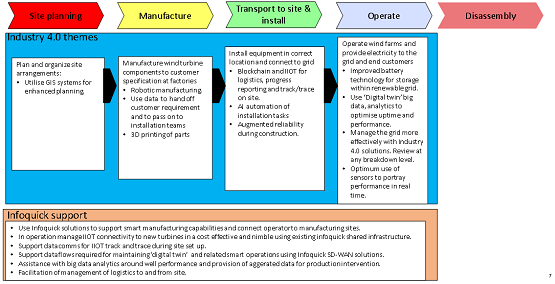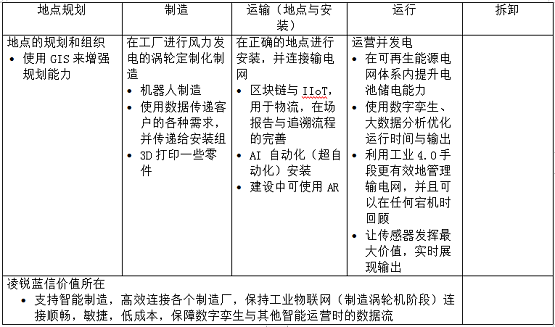来源: 阅读:- 2020-06-01 16:42:13
Use case: Industry 4.0 realisation facilitated by InfoQuick Technologies – Renewables (wind)
实例:风能系统更新
Business Drivers (业务动机)
Renewables such as wind energy, retain many of the business drivers of traditional energy production methods but they have some specific considerations:
· Nimbleness and the need to re-deploy infrastructure – Pop up operations
· Management of logistics to and from the site.
· Optimising the lifecycle of the turbines.
· Managing the turbines to peak full potential performance.
· Minimising dedicated manpower by working in an automated manner.
· Minimising downtime.
· Delivering product at a competitive strike price compared with other energy producers.
· Managing increasing turbine sizes and more challenging locations such as offshore.
风能系统的更新再利用,与其他传统能源生产方式保有相同的业务动机,但仍然需要特别考虑几点:
· 敏捷性以及基础设施的再利用——临时突发性项目
· 物流管理
· 优化涡轮的生命周期
· 管理涡轮机在运行中实现设计动力输出
· 将人力减少到最低,提高自动化运营
· 将停工时间降到最低
· 风力能源的销售价格要有竞争力
· 管理涡轮尺寸以及更具有挑战性地点的部署,比如在海上
Business model (业务模式)
For renewables(wind) the lifecycle of the business model is described as follows:
· Planning site.
· Construction / manufacture /assembly. Often needing to manage multiple supplies.
· Transportation to site.
· Further assembly installation.
· Operation.
· Disassembly at end of life.
风能系统更新的业务模式:
· 地点规划
· 建设、制造、组装,一般都需要管理多重供应链
· 运输至现场
· 更进一步的组装、安装
· 运营
· 生命周期结束时的拆卸
Adoption of Industry 4.0 elements underpinned by InfoQuick Technologies
The following explains some of the industry 4.0 alignments

Figure 4 Renewables (wind) Industry 4.0 themes and InfoQuick support

There are some key notes in terms of how InfoQuick SD-WAN can be supportive of Industry 4.0 principles in the Wind energy sector:
· For wind energy an asset based approach is taken to build, optimise and operate a best in class wind turbine. To support operations a ‘digital twin’ is created and maintained in parallel. Actual performance from the Wind farm is collected and compared against the target virtual performance of the ‘digital twin’ for any particular turbine – each individual turbine can be modelled with its specifics and tuned in this fashion, this opens up huge performance improvement potential and drives a pro-active approach to maintenance. It requires sensor technology and IIoT connectivity, big data / analytics for this to happen. These challenges can be assisted in the field by adoption of InfoQuick SD-Wan and cloud capabilities.
· Robotic technologies are already in use for the fabrication of wind turbines. Factories are also using IT to share information on delivery and collaborate on production requirements. Data relevant to populating the digital twin is created and assists with installation and operation. Data from operations can also be fed back into the manufacturing phase to deliver future improvements.
· Part information is now being exchanged in data to streamline manufacture and delivery. It also avoids costly re-work.
· Utilisation of emerging battery technologies which allow surplus generated electricity to be stored and fed back into the grid when needed. Again, these need to be connected to IIoT with InfoQuick offering support capabilities
· Use of Cyber physical systems (CPS), big data and analytics as well IIoT to manage the renewable power grid and turbines in an optimum manner.
几个关键环节:
· 风能系统,遵循基于能源产地的运营方式,就是建造、优化、运行良好状态的涡轮机。为了更好地支持运行,数字孪生与真实环境平行运维。任何一个涡轮机的实际输出数据都可以被收集并与数字模型情况对比,这种新型模式,可以根据每一个涡轮的实际运行情况,实时校正其数字模型。这将开拓巨大的提升输出潜力,并推动前瞻性的运维方式。而所有这些都需要顺畅连接传感器技术、工业物联网,与大数据分析,凌锐蓝信可以提供支持。
· 机器人技术已经应用到涡轮机的制造装配流程中。工厂也在利用IT技术分享信息到交付,并与产品需求方合作。相关数据可输送到“数字孪生”,有助于安装与运行。从运行反馈回到制造方的数据有助于未来的改善。
· 零部件的数字信息,被实时传送给制造与交付环节,以简化流程,避免重复工作的成本。
· 新兴电池技术的利用,可以将过剩电量储存起来并在需要时传回输电网。这也需要连接IIoT来实现。
· 使用数字物理系统(CPS)、大数据分析、工业物联网,管理可再生能源输电网与涡轮机,使它们时刻运行在最佳状态。
(正文已结束)
免责声明及提醒:此文内容为本网所转载企业宣传资讯,该相关信息仅为宣传及传递更多信息之目的,不代表本网站观点,文章真实性请浏览者慎重核实!任何投资加盟均有风险,提醒广大民众投资需谨慎!